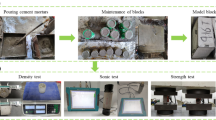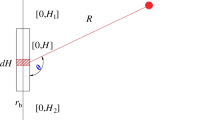Abstract
The surrounding rock is divided into elastic zone and plastic zone according to the motion and deformation characteristics of medium in rock blasting. Cylindrical charge blasting vibration is framed based on past research related to blasting elastic–plastic theory, and the influence of detonation velocity on cylindrical blasting vibration is considered, especially for long charge length. A superposition model is used to calculate the vibration characteristics of long cylindrical charge blasting while considering the influence of charge length. The analysis results show that when the charge length reaches a certain length, the peak particle velocity (PPV) no longer increases with an increase in charge length, which is not consistent with the traditional theory for PPV calculation. In current practice, the calculation method for spherical charge blasting is used to calculate PPV values for a cylindrical charge. This approach, however, is inaccurate. As such, a new modified PPV calculation formula that considers the characteristics of cylindrical blasting is proposed in this paper after comparing with the spherical blasting PPV calculation method, and the influencing factor of charge length is introduced. The new PPV calculation formula can better characterize cylindrical charge blasting vibration attenuation laws.
















Similar content being viewed by others
References
Abozena AM (1977) Radiation from a finite cylindrical explosive source. Geophysics 42:1384–1393. doi:10.1190/1.1440799
Birch WJ, Pegden M (2014) Improved prediction of ground vibrations from blasting at quarries. Trans Inst Min Metall 109:102–106. doi:10.1179/mnt.2000.109.2.102
Blair DP (2007) A comparison of Heelan and exact solutions for seismic radiation from a short cylindrical charge. Geophysics 72:E33–E41. doi:10.1190/1.2424543
Blair DP (2008) Non-linear superposition models of blast vibration. Int J Rock Mech Min Sci 45:235–247. doi:10.1016/j.ijrmms.2007.05.002
Blair DP (2010) Seismic radiation from an explosive column. Geophysics 75:E55–E65. doi:10.1190/1.3294860
Blair DP (2014) Blast vibration dependence on charge length, velocity of detonation and layered media. Int J Rock Mech Min Sci 65:29–39. doi:10.1016/j.ijrmms.2013.11.007
Blair DP, Jiang JJ (1995) Surface vibrations due to a vertical column of explosive. Int J Rock Mech Min Sci Geomech Abstr 32:149–154. doi:10.1016/0148-9062(94)00036-3
Blair DP, Minchinton A (1997) On the damage zone surrounding a single blasthole. Fragblast 1:59–72. doi:10.1080/13855149709408390
Blake FG (1952) Spherical wave propagation in solid media. J Acoust Soc Am 24:211–215. doi:10.1121/1.1906882
Chen S (1998) Theory and technology of modern drilling and blasting. China Coal Industry Publishing House, Beijing
Chen S, Wei H, Du R, Zhang A (2011) Analysis of blasting seismic effect about building structure. China Coal Industry Publishing House, Beijing
Cohen T, Masri R, Durban D (2010) Shock waves in dynamic cavity expansion. J Appl Mech 77:0410091–0410098. doi:10.1115/1.4000914
Commission NDaR (2007) Construction technical specification on rock-foundation excavating engineering of hydraulic structures. Beijing
Duvall WI (1953) Strain-wave shapes in rock near explosions. Geophysics 18:310–323. doi:10.1190/1.1437875
Favreau RF (1969) Generation of strain waves in rock by an explosion in a spherical cavity. J Geophys Res Atmos 74:4267–4280. doi:10.1029/JB074i017p04267
Grant JR, Spathis AT, Blair DP (1987) An investigation of the influence of charge length upon blast vibrations. In: 6th ISRM congress international society for rock mechanics, pp 637–641
Guo Z-Q (1982) Waves in solids. Seismological Press, Beijing
Heelan PA (1953) Radiation from a cylindrical source of finite length. Geophysics 18:685–696. doi:10.1190/1.1437923
Hildyard MW, Milev AM (2001) Simulated rockburst experiment: development of a numerical model for seismic wave propagation from the blast, and forward analysis. J S Afr Inst Min Metall 101:235–245
Hudaverdi T, Akyildiz O (2017) Investigation of the site-specific character of blast vibration prediction. Environ Earth Sci 76:138. doi:10.1007/s12665-017-6456-5
Larson DB (1982) Explosive energy coupling in geologic materials. Int J Rock Mech Min Sci Geomech Abstr 19:157–166. doi:10.1016/0148-9062(82)90886-5
Li XL, He LH, Wang XY, Guan S, Li KG (2016) Research on the influence of blasting vibration characteristics of hole-by-hole total charge blasting. Mater Res Innov 19:S8-953–S958-958. doi:10.1179/1432891715Z.0000000001892
Meng J-F, Hui H-B (1992) Blasting testing technology. Metallurgy Industry Press, Beijing
Roy MP, Singh PK, Mishra AK, Jawed M (2014) Impact of total explosive weight detonated in blasting round on blast induced ground vibration. World Min Surf Undergr 66:177–182
Schenk V (1973) Source function of stress waves of a spherical explosive source. Pure AAppl Geophys 109:1743–1751. doi:10.1007/BF00876100
Sharpe JA (1942a) The production of elastic waves by explosion pressures. I. Theory and empirical field observations. Geophysics 7:144–154. doi:10.1190/1.1445002
Sharpe JA (1942b) The production of elastic waves by explosion pressures. II. Results of observations near an exploding charge. Geophysics 7:311–321. doi:10.1190/1.1445016
Singh PK, Roy MP, Sinha A (2014) Initiation mode of explosives vis-a-vis blast performance. J Mines Metals Fuels 62:145–151
Starfield AM, Pugliese JM (1968) Compression waves generated in rock by cylindrical explosive charges: a comparison between a computer model and field measurements. Int J Rock Mech Min Sci Geomech Abstr 5:65–77. doi:10.1016/0148-9062(68)90023-5
Trivino LF, Mohanty B (2015) Assessment of crack initiation and propagation in rock from explosion-induced stress waves and gas expansion by cross-hole seismometry and FEM–DEM method. Int J Rock Mech Min Sci. doi:10.1016/j.ijrmms.2015.03.036
Triviño LF, Mohanty B, Milkereit B (2012) Seismic waveforms from explosive sources located in boreholes and initiated in different directions. J Appl Geophys 87:81–93. doi:10.1016/j.jappgeo.2012.09.004
Vanbrabant F, Enrique PC, Luis AQ (2002) P and S Mach waves generated by the detonation of a cylindrical explosive charge—experiments and simulations. Fragblast. doi:10.1076/frag.6.1.21.8849
Wang DS, Min G, Wang ZX, Zhang WZ (2011) Blast stress field of linear explosive charge and its application to medium-depth hole blasting in underground mine. Explos Shock Waves 31:355–360
Acknowledgements
This research was supported by the National Nature Science Foundation of China under Grant 11672112, the Specialized Research Fund for the Doctoral Program of Higher Education of China (Grant No. 20113718110002) and the Fund of the State key Laboratory of Disaster Prevention & Mitigation of Explosion & Impact (PLA University and Technology) (No. DPMEIKF201307), Huaqiao University Research Foundation (13BS402).
Author information
Authors and Affiliations
Corresponding author
Rights and permissions
About this article
Cite this article
Chen, S., Wu, J. & Zhang, Z. Blasting vibration characteristics and PPV calculation formula considering cylindrical charge length. Environ Earth Sci 76, 674 (2017). https://doi.org/10.1007/s12665-017-7027-5
Received:
Accepted:
Published:
DOI: https://doi.org/10.1007/s12665-017-7027-5




